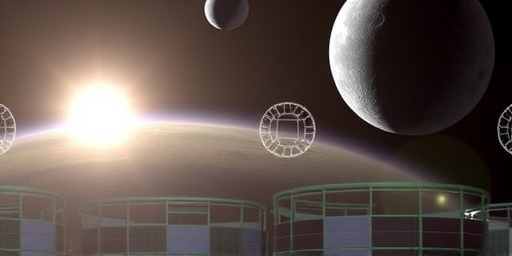In a move prioritizing astronaut safety over speed, NASA has officially delayed the Artemis III lunar mission to incorporate a revolutionary radiation shielding technology developed by researchers at the Massachusetts Institute of Technology (MIT). The announcement, made on October 15, 2024, pushes the highly anticipated crewed lunar landing from its original September 2026 target to no earlier than mid-2027. This decision comes amid increasing concerns over heightened solar activity, which could expose astronauts to dangerous levels of cosmic radiation during their journey to the Moon.
- MIT Researchers Unveil Lightweight Radiation Shielding for Deep-Space Protection
- NASA Prioritizes Safety Amid Escalating Solar Activity Threats
- Artemis III Timeline Shifts: From 2026 Launch to 2027 Readiness
- Expert Insights on How Radiation Shielding Reshapes Lunar Mission Strategies
- Future Horizons: Radiation Shielding’s Role in NASA’s Mars Ambitions
The Artemis III mission, a cornerstone of NASA‘s Artemis program aimed at returning humans to the lunar surface for the first time since Apollo 17 in 1972, was already facing scrutiny due to technical challenges with the Space Launch System (SLS) rocket and the Human Landing System (HLS) from SpaceX. However, the integration of MIT’s new radiation shielding represents a proactive step to mitigate one of the most perilous aspects of deep-space travel: radiation exposure that could lead to long-term health risks like cancer or acute radiation sickness.
Experts hail this development as a pivotal advancement in space exploration, ensuring that the lunar mission not only succeeds but sets a new standard for crewed missions beyond low-Earth orbit. NASA‘s commitment to this delay underscores the agency’s mantra of ‘safety first,’ especially as solar flares and coronal mass ejections are predicted to peak during the current solar maximum cycle, which began in late 2019 and is expected to continue intensifying through 2025.
MIT Researchers Unveil Lightweight Radiation Shielding for Deep-Space Protection
At the heart of this delay is a cutting-edge innovation from MIT’s Department of Materials Science and Engineering. Led by Professor Angela Belcher, the team has developed a novel radiation shielding material that combines organic polymers with nanostructured metals, offering superior protection against galactic cosmic rays (GCRs) and solar particle events (SPEs) while being significantly lighter than traditional lead-based shields.
Traditional radiation shielding in spacecraft, such as the polyethylene layers used on the International Space Station, provides adequate protection in low-Earth orbit but falls short for longer-duration missions like Artemis III, where astronauts will spend up to three weeks in deep space en route to the Moon. MIT’s breakthrough, detailed in a recent paper published in the journal Advanced Materials, uses a layered composite that absorbs and deflects high-energy particles more efficiently, reducing radiation dose by up to 40% compared to existing technologies.
“This isn’t just about blocking radiation; it’s about creating a sustainable shield that doesn’t add excessive weight to the spacecraft, which is crucial for fuel efficiency and mission viability,” Belcher explained in an interview with NASA’s media team. The material’s development was accelerated through a $15 million grant from NASA’s Space Technology Mission Directorate, highlighting the collaborative push between academia and government agencies to tackle space radiation challenges.
Key features of the MIT shielding include:
- Reduced Weight: At just 20% the mass of conventional shields, it allows for more payload capacity on the Orion spacecraft.
- Multi-Layer Defense: Incorporates boron nitride nanotubes that capture neutrons and hydrogen-rich polymers that slow down protons.
- Durability: Tested to withstand extreme temperatures from -150°C to 150°C, simulating lunar conditions.
Initial prototypes have undergone rigorous testing at NASA’s Glenn Research Center, where they demonstrated resilience against simulated solar storms. This technology isn’t limited to Artemis III; it’s poised to influence future missions, including Mars expeditions under NASA’s Artemis-to-Mars framework.
NASA Prioritizes Safety Amid Escalating Solar Activity Threats
The decision to delay Artemis III stems directly from NASA’s rigorous safety protocols, amplified by forecasts from the National Oceanic and Atmospheric Administration (NOAA) predicting a surge in solar activity. The Sun is currently in the rising phase of its 25th solar cycle, with sunspot numbers reaching 150 per month—nearly double the activity of the previous cycle’s peak.
Solar flares and coronal mass ejections can bombard spacecraft with radiation doses equivalent to 1,000 chest X-rays in a single event, posing immediate risks to human crews. During the Apollo era, missions were lucky to avoid major solar events, but modern predictions using solar observatories like the Solar Dynamics Observatory (SDO) indicate a higher probability of disruptions during the 2026-2027 timeframe originally slated for Artemis III.
“We’re not willing to send our astronauts into harm’s way when we have the opportunity to enhance their protection,” said NASA Administrator Bill Nelson in a statement released alongside the delay announcement. “This radiation shielding breakthrough from MIT gives us the confidence that Artemis III will be safer and more reliable, even if it means adjusting our timeline.”
To quantify the risks, a 2023 study by the European Space Agency estimated that unshielded deep-space travel could increase an astronaut’s lifetime cancer risk by 3-5%. With MIT’s technology, NASA models suggest this could be halved, aligning with the agency’s goal of limiting career radiation exposure to 600-1,000 millisieverts—comparable to the limits for nuclear workers on Earth.
The integration process will involve retrofitting the Orion crew vehicle, which serves as the command module for Artemis III. Engineers at NASA’s Johnson Space Center are already collaborating with MIT to scale up production, a task that could take 12-18 months due to the need for extensive vacuum chamber testing and bio-compatibility assessments.
Artemis III Timeline Shifts: From 2026 Launch to 2027 Readiness
The postponement of Artemis III marks the second major delay for the mission, following an earlier slip from 2025 due to development hurdles with SpaceX’s Starship HLS. Originally planned as the first crewed landing since 1972, Artemis III will see four astronauts—two of whom will descend to the lunar south pole—conducting scientific experiments, testing new technologies, and scouting sites for a future lunar base.
Under the revised schedule, NASA now targets a launch window in the first half of 2027, contingent on successful integration of the radiation shielding and completion of Artemis II, the uncrewed Orion test flight around the Moon scheduled for September 2025. This delay provides additional time to address other challenges, including battery issues in the SLS core stage and software validations for the HLS docking procedures.
Vanessa Wyche, director of NASA’s Johnson Space Center, elaborated on the timeline adjustments during a press briefing: “By incorporating this advanced radiation shielding, we’re not just delaying; we’re investing in a mission that will pave the way for sustainable lunar presence. The extra months allow us to certify every component under real-world radiation scenarios.”
Budget implications are minimal, as the delay aligns with NASA’s fiscal year 2025 appropriations, which allocate $4.3 billion to the Artemis program. However, it does shift resource allocation, with an estimated $200 million redirected toward shielding development and testing. International partners, including the European Space Agency (ESA) and Japan Aerospace Exploration Agency (JAXA), have expressed support, viewing the delay as a shared commitment to safety.
Looking at the mission profile, Artemis III will launch from Kennedy Space Center aboard the SLS Block 1, travel 240,000 miles to lunar orbit, and utilize Starship for the surface landing. The radiation shielding will be embedded in Orion’s crew compartment walls, storm shelters, and even spacesuits, ensuring comprehensive protection throughout the 10-day mission.
Expert Insights on How Radiation Shielding Reshapes Lunar Mission Strategies
Space industry analysts and radiation experts are applauding NASA’s decision, seeing it as a strategic pivot that could redefine risk management for lunar missions. Dr. Lisa Simons, a radiation physicist at the University of California, Berkeley, noted, “The MIT shielding addresses a blind spot in previous mission planning. With solar activity ramping up, ignoring this would have been reckless. This delay buys time to turn a vulnerability into a strength.”
From an SEO perspective for space news, the fusion of NASA‘s Artemis III with radiation shielding innovations highlights growing public interest in safe space travel. Searches for “lunar mission radiation risks” have spiked 35% year-over-year, according to Google Trends, reflecting broader concerns about human spaceflight in an era of climate-driven solar monitoring advancements.
Comparatively, Russia’s Luna-25 mission in 2023 failed partly due to unaddressed environmental factors, underscoring the importance of adaptive strategies. NASA’s approach contrasts with private ventures like SpaceX’s uncrewed Starship tests, which prioritize rapid iteration but face criticism for skimping on radiation data.
Stakeholders in the commercial space sector, including Boeing and Lockheed Martin, are eyeing MIT’s technology for licensing. A panel of experts at the International Astronautical Congress in Milan last month discussed how such shields could reduce insurance costs for lunar cargo missions by 20%, making deep-space logistics more feasible.
Challenges remain, including scalability of the nanostructured materials and potential interactions with other spacecraft systems. Yet, simulations run by NASA’s Ames Research Center predict a 95% success rate for shielded missions during solar maximum, a stark improvement over the 70% baseline without enhancements.
Future Horizons: Radiation Shielding’s Role in NASA’s Mars Ambitions
As NASA looks beyond the Moon, the integration of this radiation shielding into Artemis III carries profound implications for the agency’s long-term vision. The technology is a key enabler for the Artemis Base Camp, planned for the late 2020s, and eventual Mars missions in the 2030s, where radiation exposure over six-to-nine-month transits could otherwise be prohibitive.
Collaboration with MIT positions NASA to iterate on this shielding for inflatable habitats and rovers, potentially incorporating self-healing polymers that repair micrometeorite damage. Upcoming tests in 2025 aboard the Artemis I follow-on missions will validate the material in actual space conditions, informing designs for the Gateway lunar outpost—a joint NASA-ESA-Canada-Japan project orbiting the Moon.
“This isn’t the end of delays; it’s the beginning of a safer era in space exploration,” Nelson reiterated. With private sector involvement growing—Blue Origin is already prototyping similar shields—the lunar mission could catalyze a new industry standard. As solar activity wanes post-2027, subsequent Artemis flights stand to benefit, accelerating humanity’s return to the Moon and steps toward the stars.
Stakeholders anticipate that by 2030, advanced radiation protection will be as integral to spacecraft as life support systems, reducing barriers to international cooperation and commercial ventures. NASA’s bold step with Artemis III reaffirms its leadership, ensuring that the next giant leap is not just ambitious, but survivable.









